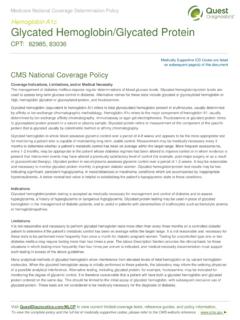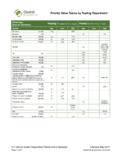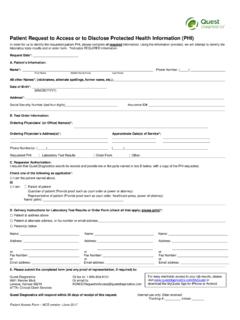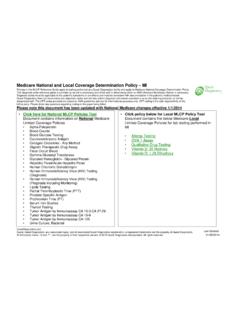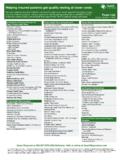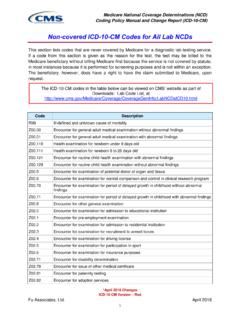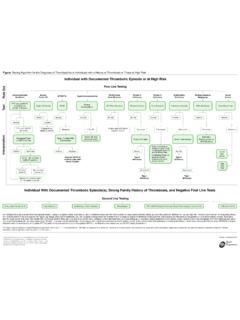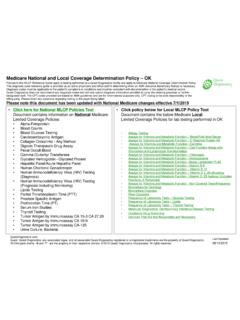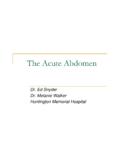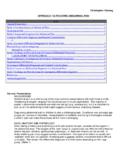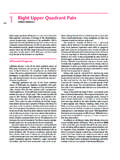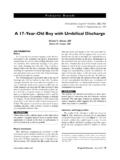Transcription of Hepatitis Panel/Acute Hepatitis Panel - Quest …
1 CPT: Medicare National Coverage Determination Policy CMS National Coverage Policy Medically Supportive ICD Codes are listed on subsequent page(s) of this document Visit to view current limited coverage tests, reference guides, and policy information. To view the complete policy and the full list of medically supportive codes, please refer to the CMS website reference Right Click Hyperlink to Add CMS URL Add full policy information Template structure: First level is for headers such as limitations, indications and usage guidelines Second level is for main body copy Third level is for bullet (if needed) To apply styles to copy, select copy and use the promote and demote under the home tab Helpful hint: be sure to hit Reset button to apply master once all copy is in template to apply styles 80074 Hepatitis Panel / acute Hepatitis Panel Coverage Indications, Limitations, and/or Medical Necessity This Panel consists of the following tests: Hepatitis A antibody (HAAb), IgM antibody; Hepatitis B core antibody (HBcAb), IgM antibody; Hepatitis B surface antigen (HBsAg); and Hepatitis C antibody.
2 Hepatitis is an inflammation of the liver resulting from viruses, drugs, toxins, and other etiologies. Viral Hepatitis can be due to one of at least five different viruses, designated Hepatitis A, B, C, and E. Most cases are caused by Hepatitis A virus (HAV), Hepatitis B virus (HBV), or Hepatitis C virus (HCV). HAV is the most common cause of Hepatitis in children and adolescents in the United States. Prior exposure is indicated by a positive IgG anti-HAV. acute HAV is diagnosed by IgM anti-HAV, which typically appears within four weeks of exposure, and which disappears within three months of its appearance. IgG anti-HAV is similar in the timing of its appearance, but it persists indefinitely. Its detection indicates prior effective immunization or recovery from infection. Although HAV is spread most commonly by fecal-oral exposure, standard immune globulin may be effective as a prophylaxis. HBV produces three separate antigens (surface, core, and e (envelope) antigens) when it infects the liver, although only Hepatitis B surface antigen (HBsAg) is included as part of this Panel .
3 Following exposure, the body normally responds by producing antibodies to each of these antigens; one of which is included in this Panel : Hepatitis B surface antibody (HBsAb)-IgM antibody. HBsAg is the earlier marker, appearing in serum four to eight weeks after exposure, and typically disappearing within six months after its appearance. If HBsAg remains detectable for greater than six months, this indicates chronic HBV infection. HBcAb, in the form of both IgG and IgM antibodies, are next to appear in serum, typically becoming detectable two to three months following exposure. The IgM antibody gradually declines or disappears entirely one to two years following exposure, but the IgG usually remains detectable for life. Because HBsAg is present for a relatively short period and usually displays a low titer, a negative result does not exclude an HBV diagnosis . HBcAb, on the other hand, rises to a much higher titer and remains elevated for a longer period of time, but a positive result is not diagnostic of acute disease, since it may be the result of a prior infection.
4 The last marker to appear in the course of a typical infection is HBsAb, which appears in serum four to six months following exposure to infected blood or body fluids; in the , sexual transmission accounts for 30% to 60% of new cases of HBV infection. The diagnosis of acute HBV infection is best established by documentation of positive IgM antibody against the core antigen (HBcAb-IgM) and by identification of a positive Hepatitis B surface antigen (HBsAg). The diagnosis of chronic HBV infection is established primarily by identifying a positive Hepatitis B surface antigen (HBsAg) and demonstrating positive IgG antibody directed against the core antigen (HBcAb-IgG). Additional tests such as Hepatitis B e antigen (HBeAg) and Hepatitis B e antibody (HBeAb), the envelope antigen and antibody, are not included in the Hepatitis Panel , but may be of importance in assessing the infectivity of patients with HBV. Following completion of a HBV vaccination series, HBsAb alone may be used monthly for up to six months, or until a positive result is obtained, to verify an adequate antibody response.
5 HCV is the most common cause of post-transfusion Hepatitis ; overall HCV is responsible for 15% to 20% of all cases of acute Hepatitis , and is the most common cause of chronic liver disease. The test most commonly used to identify HCV measures HCV antibodies, which appear in blood two to four months after infection. False positive HCV results can occur. For example, a patient with a recent yeast infection may produce a false positive anti-HCV result. For this reason, at present positive results usually are confirmed by a more specific technique. Like HBV, HCV is spread exclusively through exposure to infected blood or body fluids. This Panel of tests is used for differential diagnosis in a patient with symptoms of liver disease or injury. When the time of exposure or the stage of the disease is not known, a patient with continued symptoms of liver disease despite a completely negative Hepatitis Panel may need a repeat Panel approximately two weeks to two months later to exclude the possibility of Hepatitis .
6 Once a diagnosis is established, specific tests can be used to monitor the course of the disease. Indications 1. To detect viral Hepatitis infection when there are abnormal liver function test results, with or without signs or symptoms of Hepatitis . 2. Prior to and subsequent to liver transplantation. Limitations After a Hepatitis diagnosis is established, only individual tests are needed. CPT: Code Description Medicare National Coverage Determination Policy The ICD10 codes listed below are the top diagnosis codes currently utilized by ordering physicians for the limited coverage test highlighted above that are also listed as medically supportive under Medicare s limited coverage policy. If you are ordering this test for diagnostic reasons that are not covered under Medicare policy, an Advance Beneficiary Notice form is required. *Note Bolded diagnoses below have the highest utilization Disclaimer: This diagnosis code reference guide is provided as an aid to physicians and office staff in determining when an ABN (Advance Beneficiary Notice) is necessary.
7 diagnosis codes must be applicable to the patient s symptoms or conditions and must be consistent with documentation in the patient s medical record. Quest Diagnostics does not recommend any diagnosis codes and will only submit diagnosis information provided to us by the ordering physician or his/her designated staff. The CPT codes provided are based on AMA guidelines and are for informational purposes only. CPT coding is the sole responsibility of the billing party. Please direct any questions regarding coding to the payer being billed. Last updated: Visit to view current limited coverage tests, reference guides, and policy information. To view the complete policy and the full list of medically supportive codes, please refer to the CMS website reference Right Click Hyperlink to Add CMS URL Add frequency verbiage For Code pasting from excel workbook: right click, Paste Options Keep Text Only If table format shows up in template, right click and select Keep Text Only to reformat Add Last updated date If there is a frequency associated with test, use copy: There is a frequency associated with this test.
8 Please refer to the Limitations or Utilization Guidelines section on previous page(s). If no frequency associated with test, use copy: Please refer to the Limitations or Utilization Guidelines section on previous page(s) for frequency information. Quest , Quest Diagnostics, any associated logos, and all associated Quest Diagnostics registered or unregistered trademarks are the property of Quest Diagnostics. All third-party marks and are the property of their respective owners. 2016 Quest Diagnostics Incorporated. All rights reserved. acute viral Hepatitis , unspecified Chronic viral Hepatitis C Unspecified viral Hepatitis B without hepatic coma Unspecified viral Hepatitis C without hepatic coma Unspecified viral Hepatitis without hepatic coma Toxic liver disease with Hepatitis , not elsewhere classified Unspecified cirrhosis of liver Inflammatory liver disease, unspecified Epigastric pain Generalized abdominal pain Unspecified abdominal pain R17 Unspecified jaundice Weakness Other malaise Chronic fatigue, unspecified Other fatigue Abnormal weight loss Nonspecific elevation of levels of transaminase and lactic acid dehydrogenase [LDH] Abnormal results of liver function studies Encounter for other specified special examinations 80074 Please refer to the Limitations or Utilization Guidelines section on previous page(s) for frequency information.
9 01/02/18 Hepatitis Panel / acute Hepatitis Panel
